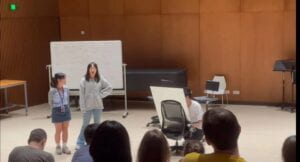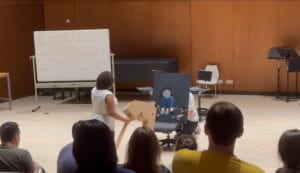The artifact that us group E has made is a mirror with the painting of a little boy on the back side. During our performance, whenever people gets happy or excited, the back side of the mirror show up and reminds people of the cruel truth that the whole town’s happiness is established on the sacrifice of the boy. Finally, everyone comes to realize that the town of Omelas needs the mirror to remind people of the truth from time to time.

Our group definitely conveys the satirical side of the story in an interactive way. When the mirror turns around, we communicate the contrast between two different ‘worlds’ by giving adequate facial and body expressions and the perfect script that we wrote :))) And I can ‘t imagine how creative we are to come up with the idea of decorating the boy’s room with real ‘garbage’ that we just used and dumped during our painting process lolll!!!! write If there’s any room for future improvement, i would say adding more interactivity to the artifact. Simply turning the mirror over and over again is a bit plain visually to the audience, and we can solve this problem by adding more scenarios and adjusting the plots to design some other interactivity like pushing the mirror down etc.
I think our artifact relates to no previous artifacts that we researched; it’s completely a brand new product. For further changes or improvement, apart from the flaw and the solution mentioned above, we can design a stand carrying the mirror that can automatically turn around when people’s attitude changes. This would be better than having one person kneeling down behind the chair and turn it with his or her hand.
As for another group for me to analyze, I would like to choose group A. The name of their artifact is The Goggles. From my point of view, their artifact meets expectation, but still need further improvement. I can fully grasp how the goggle works by watching how it respond to people’s diverse emotions when presenting on stage. It’s imaginative but can be more interactive when the goggle is reading people’s minds when it approaches them, and more physical interaction can be added instead of giving the audience the impression of the goggle is basically doing mind reading.
<iframe src=”https://drive.google.com/file/d/125qCAGjoLqkowEk1GDBBSZamcHz1BtEU/preview” width=”640″ height=”480″ allow=”autoplay”></iframe>
